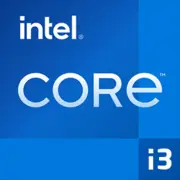Intel Core i3-7130U

Intel Core i3-7130U: A Modest Workhorse for Everyday Tasks
Analysis of a 2017 Processor in the Context of 2025
Architecture and Process Technology: The Foundation of Kaby Lake
The Intel Core i3-7130U, released in 2017, belongs to the seventh generation of Kaby Lake architecture. This 14-nanometer chip features two physical cores with Hyper-Threading support, providing 4 logical threads. Its base frequency is fixed at 2.7 GHz, and it lacks Turbo Boost—a typical limitation for budget i3s.
Integrated graphics are represented by Intel HD Graphics 620, with a base frequency of 300 MHz and a maximum dynamic frequency of 1 GHz. It supports 4K video via HDMI 1.4 or DisplayPort but is not well-suited for gaming. The Kaby Lake architecture brought optimizations in decoding HEVC and VP9 video formats, improving energy efficiency during content streaming.
Power Consumption and TDP: A Balance Between Power and Battery Life
The processor's TDP is 15 W, making it ideal for slim ultrabooks and budget laptops. Heat dissipation is managed through:
- Intel Speed Shift — dynamic frequency switching for quick responsiveness;
- Enhanced Intel SpeedStep — voltage reduction during idle periods.
Cooling in devices with this CPU is usually passive or utilizes a compact fan. By 2025, such systems rarely overheat, although throttling can occur under prolonged load (e.g., video rendering).
Performance: Modest, but Adequate for Basic Tasks
According to Geekbench 6 (2025):
- Single-Core: 849;
- Multi-Core: 1726.
Real-world Scenarios:
- Office Work: Microsoft Office, a browser with 10+ tabs, Zoom— the processor handles it, but simultaneous opening of "heavy" Excel files may cause some lag.
- Multimedia: Watching 4K videos on YouTube, Netflix—no issues thanks to hardware decoding. Editing photos in Lightroom— acceptable for basic retouching, but exporting will take time.
- Gaming: Only light titles like Among Us or Stardew Valley at low settings (720p, 30–40 FPS). CS:GO—20–25 FPS (720p), which is already unacceptable for comfortable gaming.
Turbo Mode: Absent, so frequencies do not exceed 2.7 GHz even under load. This limits peak performance.
Usage Scenarios: Who is the i3-7130U Suitable for in 2025?
- Students: For lectures, writing papers, online courses.
- Office Workers: Dealing with documents, emails, videoconferencing.
- Minimalist Users: Social media, streaming, simple editing tasks.
Not Suitable For:
- Gamers and streamers.
- Engineers working with CAD or 3D modeling.
- Video editors processing 4K footage.
Battery Life: Up to 8 Hours Under Ideal Conditions
Laptops with the i3-7130U are equipped with batteries ranging from 35 to 45 Wh. Under moderate load (browser, office applications), battery life averages 6 to 8 hours. For energy saving, features include:
- Panel Self Refresh — reduces the screen refresh rate in static scenarios;
- Connected Standby — background tasks during sleep mode.
Tip: Choose models with low-brightness IPS screens (250 nits) and SSDs instead of HDDs — this can extend battery life by 1 to 2 hours.
Comparison with Competitors: How Does It Stand Against Modern Chips?
In 2025, the i3-7130U is considered outdated, but in the budget segment, it can be compared to:
- AMD Ryzen 3 7320U (2022): 4 cores, 8 threads, Zen 2. Outperforms in multi-threaded workloads (Geekbench 6 Multi-Core ~3200) but costs more ($400–500 for a laptop).
- Apple M1 (2020): An SoC with 8 cores. 3-4 times faster in multitasking, but laptops with M1 start at $700.
- Intel N100 (2023): 4 cores, 6 W TDP. Better energy efficiency and supports modern Wi-Fi 6E standards.
Conclusion: The i3-7130U lags behind even budget newcomers, but may be justified when purchasing a used device for $150–200.
Pros and Cons: Is It Worth Buying in 2025?
Strengths:
- Low cost of laptops (new models start around $250, e.g., Lenovo IdeaPad 1).
- Adequate performance for basic tasks.
- Good energy efficiency.
Weaknesses:
- Only 2 cores—limited multitasking capabilities.
- No support for PCIe 4.0, Thunderbolt 4.
- Outdated graphics (HD 620 vs. Iris Xe or Radeon).
Laptop Selection Recommendations
If you're considering devices equipped with the i3-7130U in 2025, pay attention to:
1. Device Type: Ultrabooks with a 13–14 inch display (e.g., Acer Swift 3).
2. RAM: At least 8 GB DDR4.
3. Storage: Only SSD (256 GB or more).
4. Display: Full HD (1920×1080)—HD+ (1366×768) is outdated.
5. Ports: USB-C with Power Delivery support for fast charging.
Avoid:
- Laptops with HDDs and 4 GB of RAM.
- Models lacking support for Wi-Fi 5 (802.11ac).
Final Conclusion: Who Is This Processor For?
The Intel Core i3-7130U in 2025 is suitable for those who:
- Seek a cheap new laptop for basic tasks;
- Value battery life and portability;
- Do not plan to run "heavy" applications.
Key Benefits:
- Low price.
- Proven reliability (the 2017 architecture is well understood).
- Compatibility with Windows 10/11 and Linux.
However, if your budget allows an additional $100–150, it's better to opt for laptops with Intel N100 or AMD Ryzen 3 7320U processors—they will provide performance headroom for the next 3–4 years.
Basic
CPU Specifications
Memory Specifications
GPU Specifications
Miscellaneous
Benchmarks
Compared to Other CPU
Share in social media
Or Link To Us
<a href="https://cputronic.com/index.php/cpu/intel-core-i3-7130u" target="_blank">Intel Core i3-7130U</a>